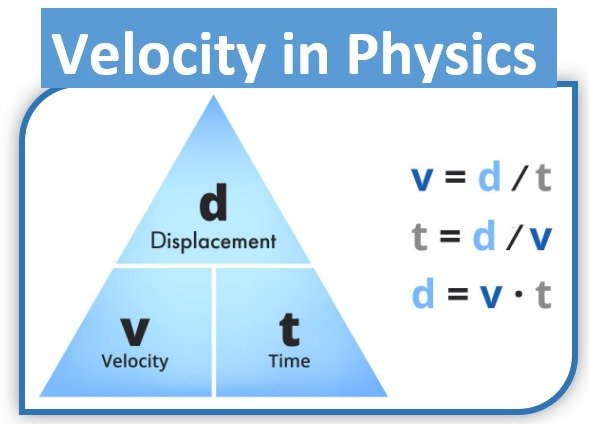Calculating Velocity in Physics
Object speed, direction, and linear, angular, and instantaneous vector quantities are all measured by velocity, which is an important concept in physics.

Velocity in Physics:
We can determine how quickly or gradually an object is traveling using the phrases speed and velocity. It occurs to us frequently that we have to decide which of two or more moving things is traveling quicker. If both vehicles are traveling the same route along the same road, it is easy to determine which is quicker. It is challenging to figure out who moves quickest when their trajectory of motion is resisting. The idea of velocity is useful in these situations.
Defination?
It is the rate at which displacement changes in relation to time.
Formula: V = s/t
In which, "s" is displacement, and "t" is time. Meter per second (m/s) is the unit of measure of velocity. It is a vector quantity having both magnitude and direction. It is calculated using both distance and displacement. There will be no velocity if the object doesn't cover any distance.
V= (xf – xi)/t =Δ x/t
Where,
xf = The final position (m)
xi = The initial position (m)
t = The time required
Δx = “The change in” position (m)
Depending on the trajectory of travel, velocity can be either negative or positive. For example, if an object is moving to the right, it is positive, and if it is moving to the left, it is negative.
Linear Velocity:
It refers to the rate at which an object or a particle moves along a straight line. It is the measure of how quickly an object changes its position in a straight line with respect to time. It is a vector quantity, meaning it has both magnitude and direction.
V = displacement/time
Symbol: It is frequently represented by the letter "v."
Unit:
Depending on the measurement system that is being employed, linear velocity can be expressed in quantities like meters per second (m/s), centimeters per second (cm/s), or kilometers per hour (km/h). It expresses the rate of motion of an item along a straight line without accounting for changes in direction.
Angular Velocity:
The rate at which an object rotates around a fixed axis is commonly referred to as its angular velocity. It gauges the speed at which an object or a spot on the object is shifting angularly over time.
Symbol: The Greek letter omega (ω) is frequently used, which is expressed in radians per second (rad/s).
According to mathematics, (ω) is defined as the change in angular displacement (θ) and time (t), which is in radians per second (rad/s), is the difference between angular displacement and time in radians (rad), and t is the difference between time and seconds (s).
Eqyation:
ω = Δθ / Δt
According to the rotation direction, the "ω" can be positive or negative. Anticlockwise rotation is indicated by a positive angular velocity, whereas clockwise rotation is indicated by a negative angular V.
Instantaneous Velocity:
It is the speed of a thing at any moment in time. The velocity at that instant, "v(t)," at a time "t," can be written as follows when an object's position is indicated as "x(t)" and time is indicated as "t":
v(t) = dx(t)/dt
Unit: Meters per second (m/s)
Average Velocity:
A measurement of the motion of an object across a specified period of time is its average velocity. It is computed by dividing the displacement (change in location) by the amount of time needed to travel the desired distance. The equation is as follows:
v = (x2 - x1) / (t2 - t1)
where x2 and x1 are the final and initial coordinates, respectively; t2 and t1 are the final and initial times; and v is the average velocity. Because it has both a magnitude and a direction, it can be considered a vector quantity. While the direction shows the direction of motion, the magnitude indicates the average speed of an object.
Relative Velocity:
The velocity of an object or observer in relation to another object or frame of reference. It describes the movement of one object or observer as seen from the perspective of another.
How to calculate?
The relative velocity is calculated by deducting the velocity of a single thing or viewer from the velocity of another. The variance between the velocities of two objects, A and B, moving in the same direction would represent the relative velocity of B with respect to A.
VB A = VB - VA
Relative velocity is a vector quantity, which means it has both magnitude and direction.
Escape Velocity:
The minimal speed required for an object to escape the gravitational influence of a celestial body, such as a planet or moon, is known as the escape velocity. It is the speed at which an item must travel in order to escape gravity and continue to move.
Mathematically, the formula that follows can be used to determine escape velocity:
The gravitational constant, or G, is roughly 6.67430 x 10-11Nm2/kg2). M denotes the heavenly body's mass.
The distance "r" between the object being studied and the celestial body's center
What's Your Reaction?





















